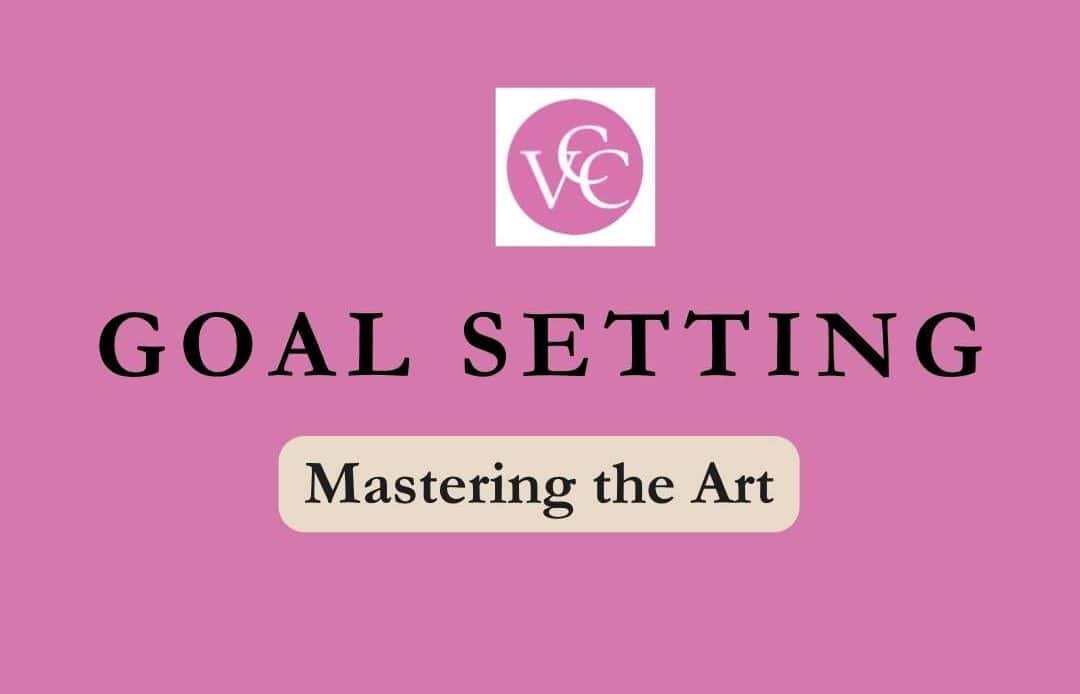
Goal setting may seem like a worn-out topic in the self-help industry, but I think it’s a profoundly spiritual practice that can lead to personal evolution and fulfillment. So, in this blog post, I will delve into the transformative power of goal setting.
Setting goals is not limited to the start of a new year; it can be done at any time, such as at the beginning of a new month. An African proverb highlights this: “Your morning begins when you wake up.”
We’ll explore a step-by-step process for setting and achieving goals, along with the mindset shifts required for success.

The Spiritual Practice of Goal Setting
The concept of the spiritual practice of goal setting:
- Emphasizes the idea that setting and working towards goals can enhance spiritual growth and alignment with your true self.
- Delves into a profound understanding of human existence, blending elements of self-awareness, intentionality, and mindfulness with the practical pursuit of objectives.
- Can be seen as a means of envisioning and manifesting your best possible future self, contrary to the belief that goal setting detracts from being present in the moment.
Let me explain further, Goal setting:
Aligns with Spiritual Growth
Spirituality often involves a journey of self-discovery and growth toward a higher state of consciousness or awareness. This perspective suggests that setting goals is not about chasing external validation or material possessions, but rather about aligning your actions with your deepest values and aspirations.
Goal setting encourages you to envision your highest potential and take tangible steps toward actualizing it. Rather than viewing goals as mere achievements, they become vehicles for your evolution and alignment with your true essence.
Involves Shifting from Scarcity to Abundance
In many spiritual teachings, there’s an emphasis on abundance as a fundamental principle of the universe.
The practice of setting goals from a place of abundance:
- involves recognizing the inherent richness of life and framing goals in terms of what you desire to create or experience, rather than what is lacking.
- means appreciating the abundance that already exists in your life, whether it be in the form of relationships, opportunities, talents, or resources. Instead of feeling like you need to achieve goals to fill a void or overcome a sense of inadequacy, you can set goals that reflect your desires for growth, fulfillment, and contribution to the world.
When you set goals from a place of abundance, you shift your focus from what you lack to what you want to create in your life. This shift in mindset is crucial because it allows you to approach goal setting with a sense of positivity, possibility, gratitude, and empowerment.
Requires Co-Creation and Surrender
From a spiritual perspective, goal setting becomes a way to co-create with the universe or higher power, tapping into the inherent creative energy that flows through all living beings. Goal setting involves a delicate balance between intentionality and surrender.
By clarifying your intentions and committing to taking action towards your goals, you become an active participant in the unfolding of your own life, rather than a passive observer. This willingness to surrender control and trust in the divine flow of life allows for serendipitous opportunities, synchronicities, and unexpected blessings to manifest along the way.
Integrates Presence and Purpose
One common concern about goal setting in spiritual circles is the perceived conflict with being present in the moment. However, the spiritual practice of goal setting reconciles this apparent dichotomy by emphasizing the importance of aligning goals with one’s present moment, experience and deeper purpose.
Instead of being a distraction from the present, goals become a means of channeling intentionality, and focus towards what truly matters to you in the here and now.
Requires Embracing the Journey and Cultivating Resilience
In spiritual traditions, the journey is often considered as significant as the destination. Similarly, the spiritual practice of goal setting acknowledges that the process of pursuing goals is as valuable as achieving them. As you strive to achieve your goals, you inevitably encounter challenges, setbacks, and moments of doubt, which are seen as valuable opportunities for growth, self-awareness, self-reflection, and resilience.
Goal setting serves as a powerful tool for cultivating resilience and adaptability in the face of adversity. The role of setbacks and obstacles as opportunities for learning and growth, emphasizes the importance of perseverance in the pursuit of goals.
Aids in Cultivating Our Inner Wisdom
Ultimately, the spiritual practice of goal setting invites us to tap into your inner wisdom and intuition. I encourage you to tap into your future selves, envisioning the achievement of your goals and then accessing the wisdom gained from that perspective.
- By aligning with your deepest values, passions, and purpose, we access a reservoir of inner strength, clarity, and creativity.
Each step taken towards a goal becomes an act and means of self-discovery, self-expression, and self-realization. This allows you to live authentically and in alignment with your highest truth.
In essence, the spiritual practice of goal setting:
- Transcends conventional notions of achievement and success, offering a holistic approach to personal growth and fulfillment.
- Invites you to embark on a journey of self-discovery, empowerment, and spiritual awakening, where every goal becomes a sacred expression of your soul’s purpose.
- Invites you to connect with our inner wisdom, trust in the unfolding of your path, and embrace the lessons and blessings that come your way along the journey toward your goals.
- Encourages you to approach your goals with mindfulness, intentionality, and a sense of reverence for the journey itself.
Ultimately, goal setting becomes not just a means to an end, but a sacred practice that deepens one’s connection to oneself, others, and the universe.

The Importance of Specificity and Visualization
Specificity in goal-setting is crucial because it provides clarity and direction. Specific goals are more achievable and actionable because they provide clarity on what needs to be done and when. By articulating your goals in the present tense with clear timeframes, you create a vivid and tangible vision of success. This concrete vision serves as a powerful motivator, fuelling determination and commitment.
Specificity
Specificity in goal-setting:
- Helps in defining the desired outcomes in detail, including the actions required, timelines, and measurable indicators of success. Without clear goals, you may feel lost or uncertain about the steps you need to take to move forward.
- Acts as a guiding light, directing efforts towards meaningful progress.
Visualization
Visualization complements specificity by engaging the power of the mind to rehearse success mentally. By vividly imagining yourself achieving your goals, you reinforce your belief in your abilities and cultivate a positive mindset.
Visualization:
- Allows you to anticipate challenges and setbacks, mentally prepare for overcoming them, and envision the rewards of achieving your goals. This mental rehearsal primes the brain for success, enhancing confidence and resilience.
- Serves as a potent tool for confronting and overcoming obstacles that may hinder your progress. By visualizing yourself successfully navigating challenges, you build confidence in your ability to overcome adversity. This proactive approach reduces fear and anxiety, allowing you to stay focused on your goals and resilient in the face of setbacks.
- Serves as a constant reminder of the destination, guiding your actions and decisions towards alignment with your goals.
Let’s get practical with a scenario:
Mimi wants to improve her physical fitness and sets a goal to run a marathon within the next year. Instead of vaguely stating her goal as “I want to run a marathon,” Mimi makes it specific by saying, “I will complete the New York City Marathon on November 1st, 2025, finishing within five hours.” She visualizes herself crossing the finish line, feeling strong and accomplished, which helps her stay motivated during training and overcome doubts and obstacles along the way.

The Role of Negative Emotions and Thoughts
Negative emotions such as fear, doubt, and shame are natural responses to setting ambitious goals. Rather than viewing these emotions as signs of failure, they should be seen as opportunities for growth and self-awareness. I encourage you to acknowledge and address these emotions as this is essential for overcoming limiting beliefs and maintaining motivation.
Techniques like “The Thought Download” would help you identify and challenge negative thought patterns, replacing them with more empowering beliefs that support your goals.
Addressing common barriers such as indecision and uncertainty, it is important to challenge thoughts that hinder your progress. The “I don’t know” mindset is identified as a significant obstacle to goal attainment, requiring us to shift towards problem-solving and action-oriented thinking.
Continuing with our practical scenario: As Mimi begins her marathon training, she experiences moments of doubt and fear, wondering if she’s capable of completing such a challenging race. Instead of ignoring these negative emotions, she acknowledges them and confronts them head-on.
Using “The Thought Download” technique, Mimi writes down her fears and doubts, such as “I’m not fast enough,” or “What if I fail?” She then challenges these thoughts by replacing them with more positive and empowering beliefs, such as “I am getting stronger every day,” or “I am capable of achieving my goals with dedication and perseverance.”

Action Planning and Setting Tasks
Writing down goals is essential because it transforms abstract desires into tangible objectives, providing direction to the brain, and a roadmap for success.
- Action planning involves breaking down larger goals into smaller, manageable tasks, focusing on the “what” and “when” rather than getting bogged down in the details of “how” to achieve them.
- Breaking down long-term goals into smaller, actionable steps is essential for maintaining momentum and preventing overwhelm.
- Setting specific tasks that align with your goals creates momentum and increases the likelihood of success. These tasks serve as powerful motivators, guiding you toward your desired outcomes and keeping you accountable for your progress.
- Establishing timelines and milestones, allows you to track your progress and adjust your approach as needed.
- Goal setting is a dynamic process that requires constant iteration and adjustment based on feedback and changing circumstances. There is a need for flexibility in your goal pursuit so that you can adapt your strategies and timelines as needed while remaining steadfast in your commitment to your overarching vision.
Continuing with our practical scenario: To prepare for the marathon, Mimi creates a detailed action plan outlining specific tasks and milestones. She breaks down her training regimen into weekly schedules, including long runs, speed workouts, and cross-training sessions. Instead of focusing on the daunting task of running 26.2 miles, Mimi concentrates on the smaller, manageable tasks each day, such as completing a five-mile run or improving her pace.
By setting these actionable tasks, Mimi builds momentum and confidence, knowing that each step brings her closer to her ultimate goal.

Embracing Unforeseen Benefits
In the pursuit of goals, we often encounter unforeseen benefits and opportunities that emerge as a result of our efforts. These incidental outcomes contribute to personal growth, new experiences, and expanded opportunities, even if the original goal is not fully realized. Some examples of this include:
- Setting up accountability structures: Sharing goals and seeking support from peers, mentors, or coaches can enhance accountability and motivation. Knowing that others are aware of your goals can motivate you to stay committed and accountable to your aspirations.
- Collaborating with others who share similar aspirations can foster a sense of community and collective progress toward individual goals. Additionally, receiving support and encouragement from others can provide valuable guidance, motivation, and perspective, helping you stay focused and resilient throughout your journey.
By embracing these unforeseen benefits, you can appreciate the journey as much as the destination, recognizing that every step taken toward your goals contribute to your overall development and success.
Continuing with our practical scenario: Throughout her marathon training journey, Mimi experiences numerous unexpected benefits and opportunities. She forms connections with fellow runners in her training group, gaining support and encouragement from like-minded individuals. Mimi discovers a newfound sense of discipline and resilience as she pushes through challenging workouts and overcomes setbacks.
Additionally, Mimi’s improved fitness levels lead to better overall health and well-being, enhancing her quality of life beyond just preparing for the marathon. Even if Mimi encounters obstacles or falls short of her original goal, she recognizes the valuable lessons learned and the personal growth achieved along the way.
By applying the principles of specificity, visualization, addressing negative emotions, strategic planning, and embracing the unforeseen benefits, Mimi enhances her chances of success in achieving her marathon goal while experiencing personal growth and fulfillment throughout her journey.

Celebrating Milestones and Progress
Recognizing and celebrating milestones and progress along the journey is vital for maintaining motivation, boosting morale, reinforcing positive behaviors, and sustaining momentum. Each step taken towards a goal, no matter how small, represents progress and deserves recognition. In celebrating achievements, whether it’s reaching a specific milestone or overcoming a significant obstacle, you acknowledge your achievements, affirm your progress, and reinforce your commitment to your goals.
Celebrations can take various forms, such as acknowledging achievements publicly, rewarding yourself for reaching milestones or expressing gratitude for the support you have received along the way. By celebrating progress, you cultivate a positive mindset, build confidence, and sustain motivation to continue pursuing your goals with enthusiasm and determination.

A Mindful Approach to Goal Setting
In conclusion, a mindful approach to goal setting serves as a powerful catalyst for personal growth. By setting goals from a mindset of abundance, addressing internal obstacles, and taking decisive action, you can manifest your dreams while nurturing self-awareness and resilience.
The incorporation of specificity, visualization, strategic planning, and embracing unexpected outcomes amplifies clarity, motivation, and overall success. Moreover, emphasizing resilience, accountability, flexibility, and celebration further enriches the goal-setting journey, enabling you to overcome challenges, stay motivated, and achieve aspirations with unwavering confidence.
Related Posts:
- The Story You Tell Yourself Is the Most Powerful One in the World
- Have You Ever Written a Letter to Your Future Self?
- 15 Powerful Strategies For Enhancing Your Intuition
- The Power of Intentionality in Personal Growth: A Journey Beyond Default Living
- The Power of Values in the Path to Happiness
- Leverage in Personal Development: Small Shifts, Big Results
- What Are The Hidden Opportunities in Your Biggest Setbacks?
At the end of the day, goals are about alignment and achievement. When you set goals with clarity and purpose, you’re creating a roadmap for the life you truly want to live. The power to transform your future is already in your hands.
Start today: pick one goal, write it down, and take your first step. Your future self will thank you. I look forward to your sharing your insights on goal setting in the comments below.
Thank you for being a VCC reader.

